
The Legend of Zelda is a high fantasy action-adventure video game franchise created by Japanese game designers Shigeru Miyamoto and Takashi Tezuka. It is primarily developed and published by Nintendo, although some portable installments and re-releases have been outsourced to Capcom, Vanpool, and Grezzo. The gameplay incorporates action-adventure and elements of action RPG games.
Here is our list of ranked Zelda games. Enjoy!
1. The Legend of Zelda: Breath of the Wild
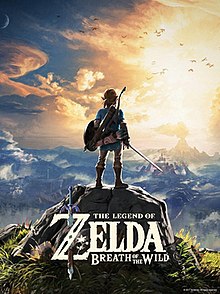
The Legend of Zelda: Breath of the Wild[b] is a 2017 action-adventure game developed and published by Nintendo for the Nintendo Switch and Wii U consoles. The game is an installment of The Legend of Zelda series and is set at the end of its timeline. The player controls an amnesiac Link, who awakens from a hundred-year slumber, and attempts to regain his memories and prevent the destruction of Hyrule by Calamity Ganon.
2. The Legend of Zelda: Ocarina of Time
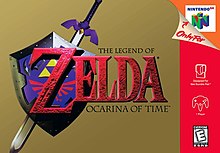
The Legend of Zelda: Ocarina of Time[a] is an action-adventure game developed and published by Nintendo for the Nintendo 64. It was released in Japan and North America in November 1998, and in PAL regions the following month. Ocarina of Time is the first game in The Legend of Zelda series with 3D graphics.
3. The Legend of Zelda: A Link to the Past

The Legend of Zelda: A Link to the Past[a] is an action-adventure game developed and published by Nintendo for the Super Nintendo Entertainment System. It is the third game in The Legend of Zelda series and was released in 1991 in Japan and 1992 in North America and Europe.
4. The Legend of Zelda: Tears of the Kingdom
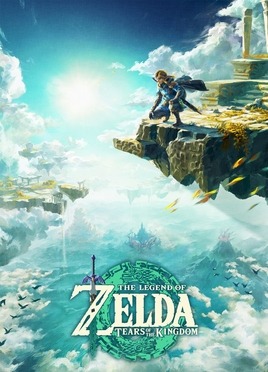
The Legend of Zelda: Tears of the Kingdom[b] is a 2023 action-adventure game developed and published by Nintendo for the Nintendo Switch. The sequel to The Legend of Zelda: Breath of the Wild (2017), the player controls Link as he searches for a missing Princess Zelda and fights to prevent the Demon King Ganondorf from destroying Hyrule. Tears of the Kingdom retains the open-world gameplay of its predecessor, and features two new areas called the sky and the Depths. The player has access to various devices that aid combat or exploration, and may use new powers that replace the Runes from its predecessor.
5. The Legend of Zelda
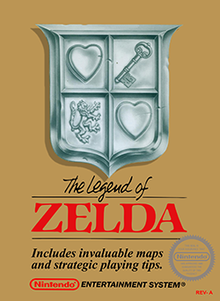
The Legend of Zelda, originally released in Japan as The Hyrule Fantasy: Zelda no Densetsu, is a 1986 action-adventure game developed and published by Nintendo. The first game of The Legend of Zelda series, it is set in the fantasy land of Hyrule and centers on an elf-like boy named Link, who aims to collect the eight fragments of the Triforce of Wisdom in order to rescue Princess Zelda from the antagonist Ganon. During the course of the game, the player controls Link from a top-down perspective and navigates throughout the overworld and dungeons, collecting weapons, defeating enemies and uncovering secrets along the way.
6. The Legend of Zelda: The Wind Waker
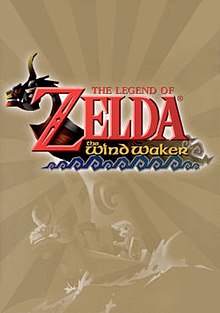
MobyGames.com
The Legend of Zelda: The Wind Waker[b] is a 2002 action-adventure game developed and published by Nintendo for the GameCube. An installment in The Legend of Zelda series, it was released in Japan in December 2002, in North America in March 2003, and in Europe in May 2003.
7. The Legend of Zelda: Majora's Mask

The Legend of Zelda: Majora's Mask[a] is a 2000 action-adventure game developed and published by Nintendo for the Nintendo 64 home console. It was released worldwide in 2000 as a main installment in The Legend of Zelda series and was the second to use 3D graphics, following 1998's The Legend of Zelda: Ocarina of Time, to which it is a direct sequel. Designed by a creative team led by Eiji Aonuma, Yoshiaki Koizumi, and Shigeru Miyamoto, Majora's Mask was completed in less than two years. It featured enhanced graphics and several gameplay changes from its predecessor, though it reused a number of elements and character models, which the game's creators called a creative decision made necessary by time constraints.
8. The Legend of Zelda: Skyward Sword
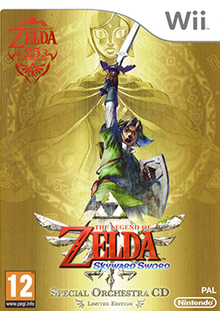
The Legend of Zelda: Skyward Sword[b] is a 2011 action-adventure game developed and published by Nintendo for the Wii. A high-definition remaster of the game, The Legend of Zelda: Skyward Sword HD, was co-developed by Tantalus Media and released for the Nintendo Switch in July 2021.
9. The Legend of Zelda: Link's Awakening

The Legend of Zelda: Link's Awakening[a] is an action-adventure game developed by Grezzo and published by Nintendo for the Nintendo Switch. Released worldwide on September 20, 2019, Link's Awakening is a remake of the 1993 game for the Game Boy. It retains the original's top-down perspective and gameplay, along with elements from the 1998 re-release Link's Awakening DX.
10. The Legend of Zelda: The Twilight Princess
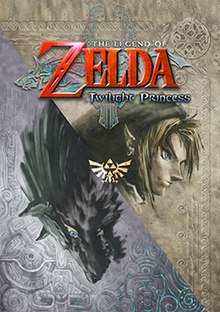
The Legend of Zelda: Twilight Princess[b] is a 2006 action-adventure game developed and published by Nintendo for the GameCube and Wii home video game consoles. Originally planned for release exclusively on the GameCube in November 2005, Twilight Princess was delayed by Nintendo to allow its developers to refine the game, add more content, and port it to the Wii.[4] The Wii version was a launch game in North America in November 2006, and in Japan, Europe, and Australia the following month. The GameCube version also released in December 2006 as the final first-party game for the console.
11. Zelda II: The Adventures of Link
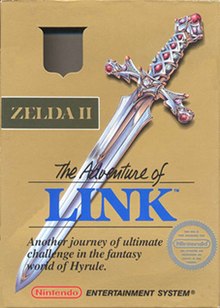
Zelda II: The Adventure of Link[a] is an action role-playing video game with platforming elements. This second installment in the Legend of Zelda series was developed and published by Nintendo for the Family Computer Disk System on January 14, 1987—less than one year after the Japanese release, and seven months before the North American release, of the original The Legend of Zelda. Zelda II was released in North America and the PAL region for the Nintendo Entertainment System in late 1988, almost two years after its initial release in Japan.
12. The Legend of Zelda: Four Swords Adventures

The Legend of Zelda: Four Swords Adventures[a] is the eleventh installment in Nintendo's The Legend of Zelda series. It was released for the GameCube home video game console in Japan on March 18, 2004; in North America on June 7, 2004; in Europe on January 7, 2005; and in Australia on April 7, 2005. The Game Boy Advance handheld game console can be used as a controller when using the GameCube – Game Boy Advance link cable bundled with the game in North America and Europe.
13. The Legend of Zelda: Link's Awakening

The Legend of Zelda: Link's Awakening[a] is a 1993 action-adventure game developed and published by Nintendo for the Game Boy. It is the first installment in the Legend of Zelda series for a handheld game console. Link's Awakening is one of the few Zelda games not to take place in the land of Hyrule, and it does not feature Princess Zelda or the Triforce relic. Instead, the protagonist Link begins the game stranded on Koholint Island, a place guarded by a whale-like deity called the Wind Fish. Assuming the role of Link, the player fights monsters and solves puzzles while searching for eight musical instruments that will awaken the sleeping Wind Fish and allow him to escape from the island.
14. The Legend of Zelda: Four Swords

The Legend of Zelda: A Link to the Past and Four Swords[a] is a compilation of two action-adventure games co-developed by Nintendo and Capcom and published by Nintendo for the Game Boy Advance. The game was released on December 2, 2002 in North America; on March 14, 2003 in Japan; and on March 28, 2003 in Europe. The cartridge contains a modified port of The Legend of Zelda: A Link to the Past, originally released for the Super Nintendo Entertainment System in 1991, and an original multiplayer-only game titled Four Swords, which serves as the 9th installment in The Legend of Zelda series.
15. The Legend of Zelda: A Link Between Worlds

The Legend of Zelda: A Link Between Worlds is an action-adventure game developed and published by Nintendo for the Nintendo 3DS. The game is an installment in The Legend of Zelda series and a spiritual successor to the 1991 Super Nintendo Entertainment System game The Legend of Zelda: A Link to the Past. Officially announced in April 2013, A Link Between Worlds was released in Australia, Europe, and North America in November 2013. A month later, it was released in Japan as The Legend of Zelda: Triforce of the Gods 2[a] (Triforce of the Gods being the Japanese title of A Link to the Past).
16. The of Zelda: Oracle of Seasons and Oracle of Ages

The Legend of Zelda: Oracle of Seasons[a] and The Legend of Zelda: Oracle of Ages[b] are two action-adventure games in the Legend of Zelda series, developed by Flagship (a subsidiary of Capcom). They were released in 2001 for Nintendo's Game Boy Color handheld console and re-released on the Virtual Console for the Nintendo 3DS in 2013. The games make up the seventh and eighth installment in the Zelda series.
17. The Legend of Zelda: Phantom Hourglass
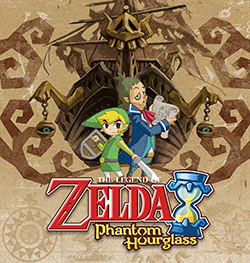
The Legend of Zelda: Phantom Hourglass[a] is a 2007 action-adventure game developed and published by Nintendo for the Nintendo DS handheld game console. It is the fourteenth installment in The Legend of Zelda series and the direct sequel to the 2002 GameCube title The Wind Waker. Phantom Hourglass was released in Japan in June 2007; in North America, Australia, and Europe in October 2007; and in South Korea in April 2008. The game was re-released for the Wii U via the Virtual Console service in the PAL region in November 2015, in North America in May 2016, and in Japan in August 2016. It earned a sequel, The Legend of Zelda: Spirit Tracks in December 2009.[2]
18. The Legend of Zelda: Tri Force Heroes
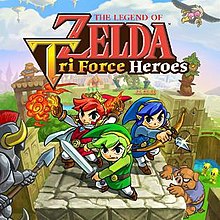
The Legend of Zelda: Tri Force Heroes[b] is an action-adventure game developed by Nintendo EPD and Grezzo and published by Nintendo for the Nintendo 3DS.[1] The second original Nintendo 3DS entry in The Legend of Zelda series after A Link Between Worlds, this game is the third installment in the franchise to prominently feature a multiplayer campaign after Four Swords and Four Swords Adventures, albeit this time with only three players as opposed to four, wireless and online connectivity as opposed to the prior games' use of link cables, and a stronger emphasis on cooperation rather than competition. The story follows the same incarnation of Link from the aforementioned A Link Between Worlds, who this time is called forth along with two other Links by the fashion-obsessed kingdom of Hytopia to lift a curse placed on their princess, Styla, from the evil Drablands Witch. It was released worldwide in October 2015 to mixed-to-positive reviews.[2]
19. The Legend of Zelda: The Minish Cap
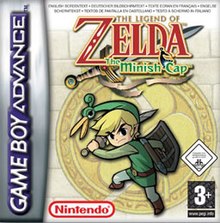
The Legend of Zelda: The Minish Cap[b] is an action-adventure video game and the twelfth entry in The Legend of Zelda series. Developed by Capcom and Flagship, with Nintendo overseeing the development process, The Minish Cap was released for the Game Boy Advance in Japan and Europe in 2004 and in North America and Australia the following year.[1] In June 2014, it was made available on the Wii U Virtual Console.
20. The Legend of Zelda: Spirit Tracks
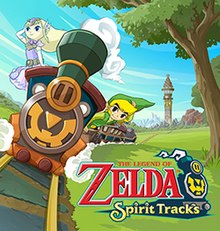
The Legend of Zelda: Spirit Tracks[a] is a 2009 action-adventure game developed and published by Nintendo for the Nintendo DS handheld game console. Set a century after The Legend of Zelda: The Wind Waker and its sequel Phantom Hourglass, the storyline follows the current incarnations of Link and Princess Zelda as they explore the land of New Hyrule to prevent the awakening of the Demon King Malladus. Players navigate New Hyrule, completing quests that advance the story and solving environmental and dungeon-based puzzles, many requiring use of the DS's touchscreen and other hardware features. Navigation between towns and dungeons is done using a train, which features its own set of mechanics and puzzles.
